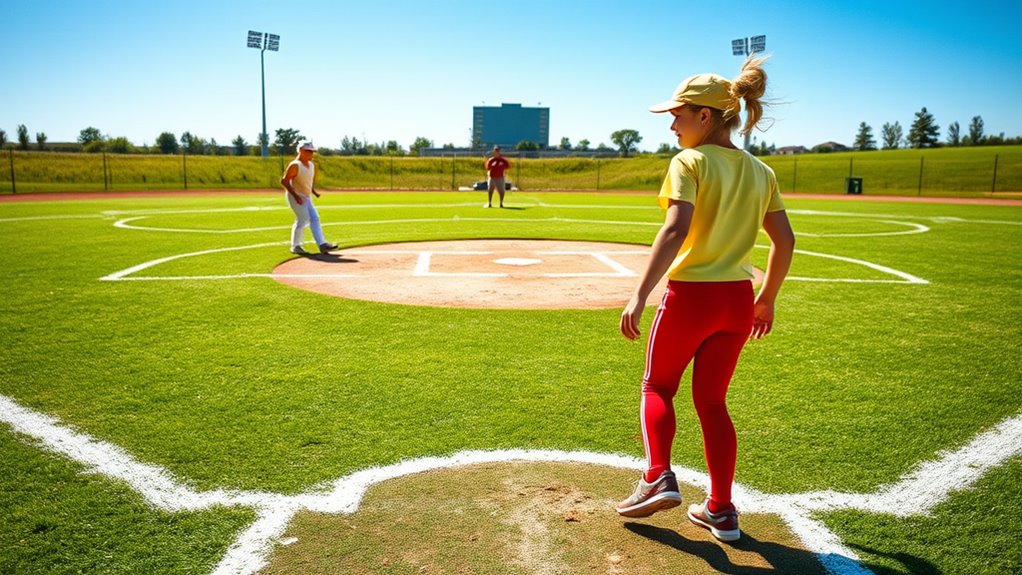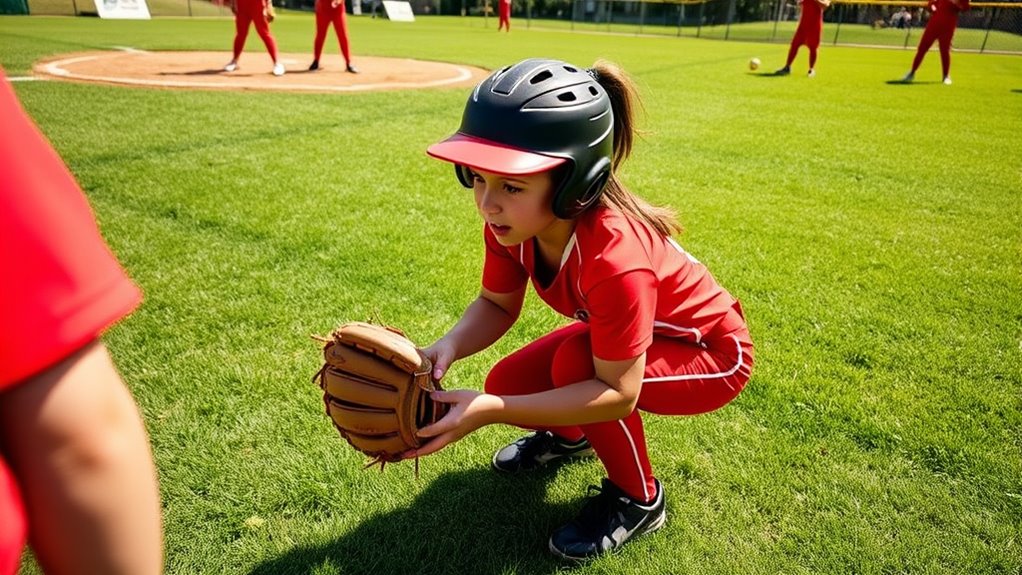When you step onto the softball field for the first time, focus on understanding the basic rules and positions. Wear the right gear, like a helmet, glove, and comfortable shoes. Learn where you’ll be on defense or offense, and practice fundamental skills like batting, catching, and throwing. Improving your accuracy and confidence takes time, but with effort, you’ll feel more prepared. Keep exploring the details, and you’ll soon be ready to enjoy your game.
Key Takeaways
- Learn the basic field positions and rules to understand game flow and your role.
- Use proper equipment, including gloves, helmets, and suitable footwear, for safety and performance.
- Practice fundamental skills like batting, catching, and throwing to build confidence and accuracy.
- Develop teamwork and communication skills for effective defensive strategies and plays.
- Focus on mental preparedness, visualization, and safety guidelines to stay confident and injury-free on the field.
Understanding the Basic Rules and Game Structure

To understand softball, understanding the basic rules and how the game is structured is vital. The game is played with two teams, each taking turns to bat and field. The goal is to score runs by hitting the ball and running around four bases. Each team gets three outs per inning, and the game typically lasts seven innings. Effective team communication is essential for coordinating plays, calling for catches, and executing game strategies. Knowing when to steal bases, bunt, or swing away can make a difference in the game’s outcome. Pay attention to the pitcher’s throws and listen to your teammates’ signals. Mastering these fundamentals helps you play confidently and work better with your team to win. Understanding slang and informal language can also enhance communication and camaraderie on the field.
Essential Softball Equipment and Gear

Having the right equipment can boost your confidence and improve your game. Protective gear is essential for safety and includes items like a helmet with a face guard, batting gloves, and sliding shorts. These protect you from injuries and help you perform at your best. Footwear options are equally important; choose cleats with good traction to stay stable on the field and prevent slips during quick movements. Make sure your shoes fit well and are suitable for softball’s demands. Additionally, a quality softball glove, a bat suited to your size and strength, and a comfortable uniform are key components. Having proper gear not only keeps you safe but also helps you focus on your game and enjoy playing softball with confidence. Understanding the best equipment choices can also give you an advantage as you learn and grow in the sport.
Getting Familiar With Field Positions and Layout

To play softball effectively, you need to understand the different field positions and how the layout works. Knowing where players stand and the boundaries of the field helps you anticipate plays and stay aware of your surroundings. Let’s explore the basics of field positions, layout, and boundaries to get you comfortable on the field. Understanding field positioning and the strategic placement of players can significantly improve your game awareness and teamwork.
Field Position Basics
Understanding the layout of a softball field is essential for knowing where players should be positioned during a game. Knowing your field position helps you stay prepared and make quick decisions. For batters, a solid batting stance sets the tone at the plate, but once the ball is in play, fielders need to be ready in their assigned spots. During fielding drills, you’ll practice moving between positions like shortstop, outfield, and first base, which helps you understand their roles. Each position has specific responsibilities, and familiarizing yourself with their layout helps you anticipate plays. As you become more comfortable with the field, you’ll quickly learn where to be for different game situations, making you a more effective player overall. Additionally, understanding the field positions on the East Coast can give you insight into regional playing styles and strategies.
Layout and Boundaries
Getting familiar with the layout and boundaries of a softball field is key to knowing where players should position themselves during a game. The field is marked with clear field markings that define foul lines, baselines, and the batter’s box, helping players gauge their positioning. Boundary enforcement guarantees players stay within their designated areas and helps umpires make fair calls. The outfield fence marks the boundary for playable area, while the infield has specific positions like pitcher’s circle and bases. Understanding these markings and boundary limits helps you stay alert during plays and communicate effectively with teammates. Recognizing the field’s layout allows you to anticipate plays better and react quickly, making your defensive and offensive efforts more effective. Additionally, understanding local regulations and field specifications ensures you’re aware of any unique boundary rules that might affect gameplay.
Fundamental Skills: Batting, Catching, and Throwing

Mastering the fundamental skills of batting, catching, and throwing is essential for becoming a confident softball player. When batting, focus on your batting stance—stand with feet shoulder-width apart, knees slightly bent, and hold the bat comfortably. Keep your eyes on the ball and swing smoothly through the strike zone. For catching, develop effective catching techniques by positioning your glove properly and moving quickly to meet the ball. Keep your hands soft and ready to absorb impact. Throwing requires proper grip and arm motion; aim to throw with accuracy and a quick, controlled release. Practice these basics consistently to build muscle memory and confidence. Mastery of these skills sets a strong foundation for your overall game and helps you contribute effectively to your team. Additionally, understanding eye patch benefits and incorporating appropriate skincare can keep your eyes refreshed and alert during long practice sessions.
Tips for Developing Your Throwing Accuracy and Power

To improve your throwing accuracy and power, focus on proper mechanics and consistent practice. Start by maintaining a stable batting stance, which helps with balance and control during throws. Keep your glove low and your arm back, then follow through with a strong, fluid motion. Incorporate fielding drills that emphasize quick, accurate throws from different angles, helping you develop muscle memory. Pay attention to your grip and release, ensuring you’re not rushing your throws. Regularly practicing these drills will build strength and precision over time. Remember, accuracy improves when you focus on controlled, deliberate movements, while power comes from engaging your core and legs. Consistent Kia Tuning modifications can also help optimize your equipment for better performance. With patience and persistence, your throws will become more accurate and powerful.
Effective Batting Techniques and Stance

A solid batting stance is the foundation for consistent and powerful hits. Your stance should feel natural yet balanced, giving you control and confidence at the plate. Focus on your grip, keep your knees slightly bent, and position your feet shoulder-width apart. As you prepare to swing, remember these key points:
- Maintain a relaxed but firm grip to enhance swing mechanics.
- Keep your eyes on the ball, tracking its path carefully.
- Keep your weight centered, shifting slightly as you swing.
- Use your hips and shoulders to generate power, ensuring smooth rotation.
- Developing a consistent batting rhythm helps improve timing and overall swing effectiveness.
Mastering your batting stance and swing mechanics boosts your confidence and accuracy, making each hit more effective and consistent. Practice these fundamentals regularly to see real improvement.
Basic Defensive Plays and Strategies

Understanding basic defensive plays and strategies is essential for stopping your opponents and gaining control of the game. Infield plays involve quick reactions, such as fielding ground balls, tagging runners, and executing double plays. Focus on positioning yourself properly to cover bases and communicate with teammates to coordinate plays. Outfield coverage requires tracking fly balls, backing up throws, and relaying them efficiently to prevent runners from advancing. Always stay alert and ready to move quickly, whether you’re rushing to catch a line drive or backing up a teammate’s throw. Practice common plays like grounders to the shortstop or third baseman, and learn when to hold runners or make a quick throw. Proper essential oil safety knowledge can help prevent injuries and ensure safe handling during the game. Mastering these strategies keeps your team organized and enhances your overall defensive effectiveness.
Tips for Building Confidence and Enjoying the Game

Ever wonder how to boost your confidence on the field and truly enjoy playing softball? Building mental toughness is key. Focus on positive self-talk and celebrating small wins to reinforce your abilities. Here are four tips to help you enjoy the game:
- Practice regularly to improve your skills and reduce anxiety.
- Trust your teammates with teamwork strategies that promote support and communication.
- Stay present in each play, avoiding dwelling on mistakes.
- Visualize successful plays to boost your confidence before the game.
- Recognize the importance of spiritual guidance and positive symbolism like angel numbers to stay motivated and aligned with your love and growth goals.
Frequently Asked Questions
How Do I Choose the Right Softball Size for My Age?
To select the right softball size, start by considering your age and level. For younger players, a smaller ball helps with control and confidence. Check your bat size and glove fit first, as they should complement your ball choice. A standard youth softball is usually 11 inches, but if you’re older, go for an 12-inch or larger. Properly fitting equipment guarantees better control and safety during play.
What Are Common Softball Injuries and How Can I Prevent Them?
Did you know softball players face injuries in about 30% of games? To prevent common ailments like sprains, strains, and wrist injuries, always warm up properly and stretch before playing. Use proper techniques and wear protective gear. Staying aware of your surroundings and practicing injury prevention strategies helps keep you safe, so you can enjoy the game and avoid setbacks from common softball injuries.
How Do I Communicate Effectively With Teammates During Gameplay?
During gameplay, effective communication with teammates is key. Use clear team signals to coordinate plays and make sure everyone’s on the same page. Combine these with verbal communication, like calling out “Mine” or “Got it,” so teammates know who’s covering the ball. Keep your tone confident and loud enough to be heard. This helps prevent confusion, boosts teamwork, and keeps the game smooth and enjoyable for everyone involved.
What Should I Wear for Different Weather Conditions?
Imagine you’re playing softball on a hot summer day, and suddenly a rainstorm hits. You’d want rain gear to stay dry and comfortable, right? For sunny days, wear sun protection like a hat, sunglasses, and sunscreen to shield yourself from UV rays. Layer lightweight clothes for warmth or windbreakers for rain. Always check the weather forecast before playing, so you’re prepared with the right gear and stay safe.
How Can I Stay Motivated to Improve My Softball Skills?
To stay motivated to improve your softball skills, focus on setting clear, achievable goals and building mental resilience. Celebrate small victories to boost your confidence, and remind yourself of your progress. When setbacks happen, stay positive and learn from them. Keep your passion alive by visualizing success and tracking your improvements. Staying committed and resilient will keep you motivated to grow and excel on the field.
Conclusion
Now that you’re stepping onto the softball field, think of yourself as a budding star ready to shine. With each practice, you’re planting seeds of confidence that will grow into skills and strategies. Remember, every game is a new chapter in your softball journey—embrace the challenge, enjoy the ride, and keep swinging. Before long, you’ll be the one lighting up the field, turning your beginner’s steps into confident strides.









